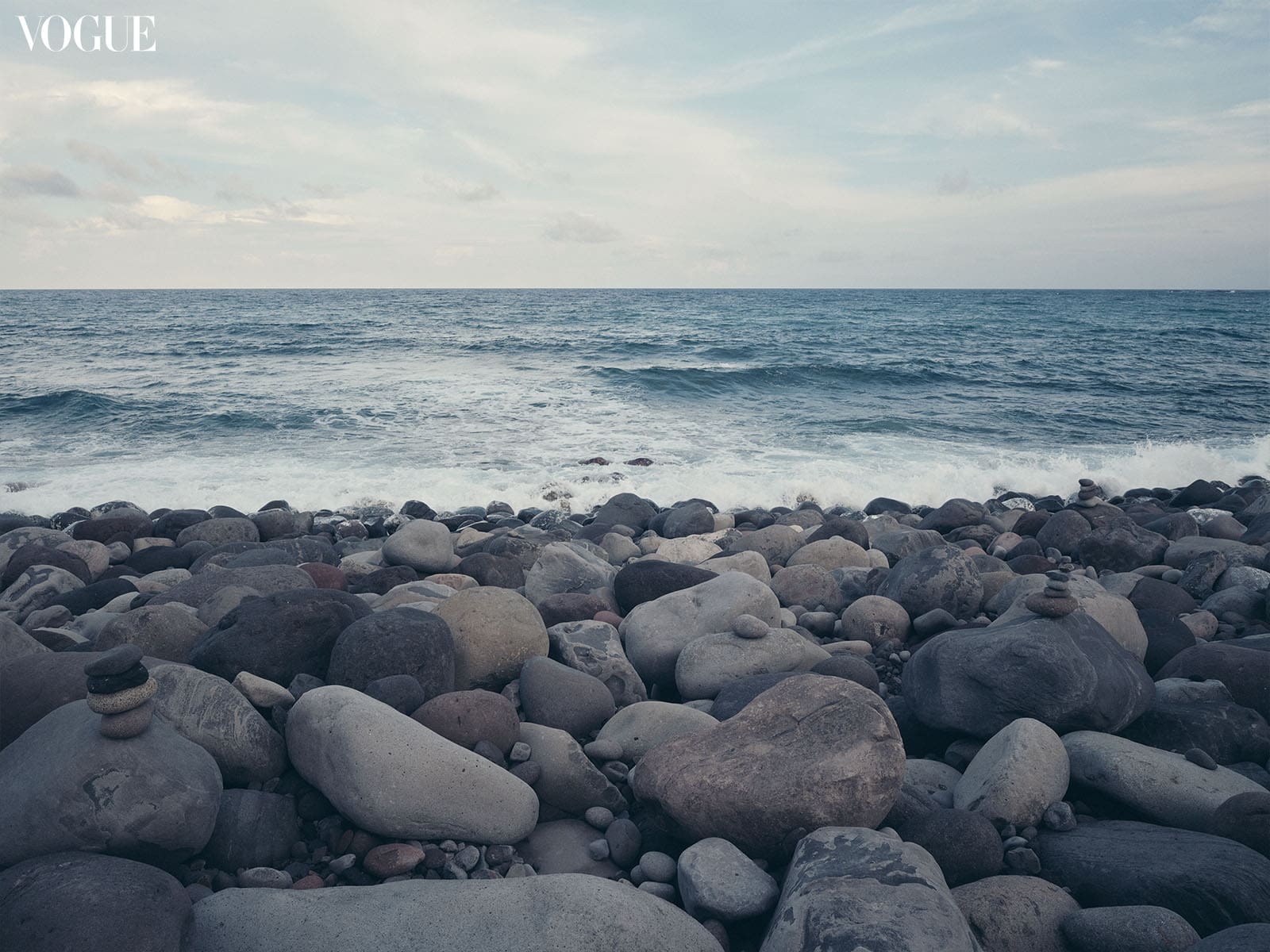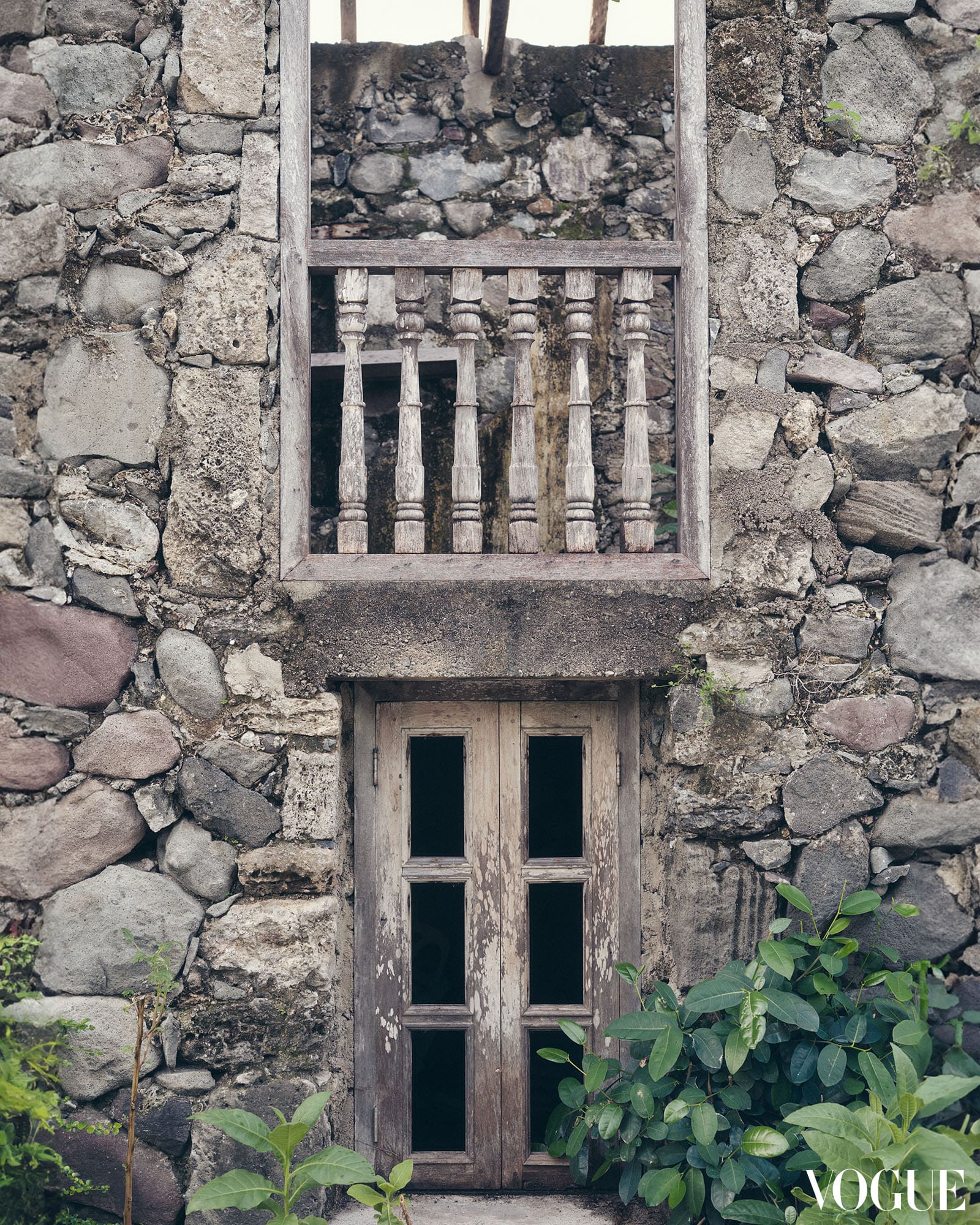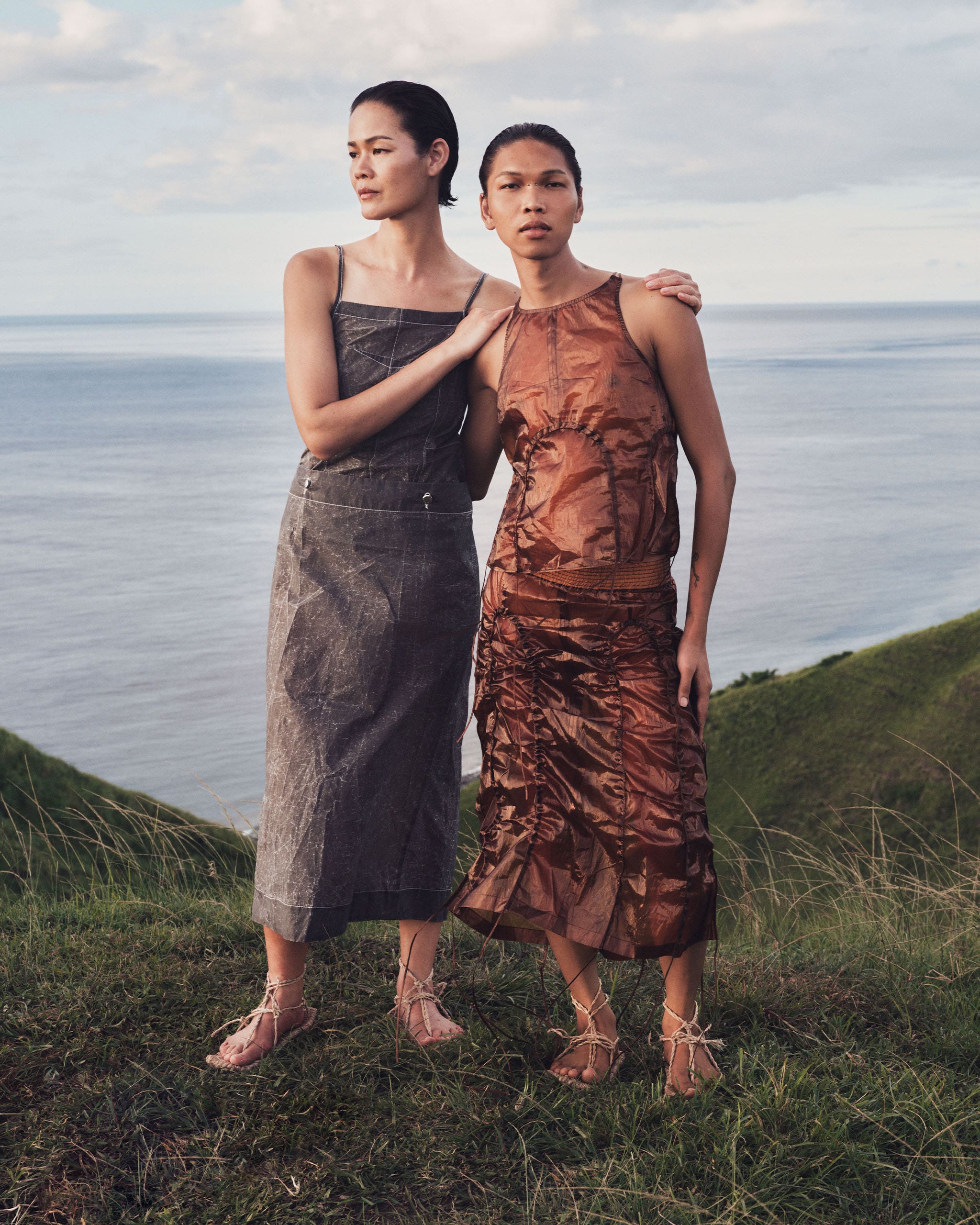Jo Ann wears a coated gray vinyl apron dress while Lukresia wears a caramel-colored “tech organza” ensemble, both from ECKHAUS LATTA. Both wear Ivatan Tukap rope sandals. Photograph by Sharif Hamza
The strong winds and seas that meet at the northernmost point of the Philippines have long capsized and commanded shipmen and adventurers; despite this, the Ivatan have made a rock-solid heritage out of adapting to their challenging environment.
Even before it became the romantic backdrop to the hit ’90s Filipino romance film Hihintayin Kita Sa Langit and before it became the much-regarded model of sustainable tourism it is today, Batanes has always been a long-held favorite among travelers of a certain, swashbuckling bend. Herman Melville’s Moby Dick, for example, memorializes Batanes in the realm of modern epics, calling the province “Bashee Isles,” a name used among whalers, shippers, and pirates who visited the islands until its establishment as a Spanish colonial state in 1783. “There is, one knows not what sweet mystery about this sea, whose gently awful stirrings seem to speak of some hidden soul beneath,” describes Ishmael, the novel’s narrator, as the ship sailed through the channel.
To this day, non-natives of Batanes still find themselves caught in the same spell experienced by centuries of seafarers and shipmen tamed yet captivated by the island’s notably intense winds and seas. But in the 4,000 years of Ivatan civilization, the cultural community indigenous to the island, the people and the land have adapted to every change and every storm the Ivatan way.

Batanes consists of several small islands, with Batan, Sabtang, and Itbayat being the three islands inhabited. Summing up to an estimated area of 20,928 hectares of land, the smallest province in the Philippines is quite literally the pagtitipon of the Pacific Ocean, the West Philippine Sea, and the Bashi and Balintang Channels. The islands are aptly known as “Home of the Winds,” with their wave-cut cliffs, arching outcrop formations, and secluded white sand beaches, visitors bear witness to the landscapes made possible by its strong winds and currents.
Nowadays, it is much easier to buy flights to Batanes, coming from airports in Manila and Tuguegarao, which will land you at the province’s capital of Basco on the island of Batan. Motorcycles, bicycles, tricycles, or walking are the common modes of transportation to get around within the islands. If you came to Batanes in contact with a travel agency, a van has likely been arranged for you to get around easily.
The people and the land have adapted to every change and every storm the Ivatan way
Before Batanes steadily became the tourist destination it is today, the Ivatan would row their way to neighboring regions on a puntin, a traditional rowing boat made of wood. Ivatan workers (boatsmen, fishermen, and farmers alike) have been known to sing in unison songs of kalusan, Ivatan folk work songs, to encourage rhythm in labor and to alleviate fatigue.
Ivatans are proud multi-hyphenates of labor, whether you’re a farmer, a fisherman, a teacher, or a tour guide, one of each is probably moonlighting as another. “I come from a family of parents who were farmers. I helped in farming but my father was also a fisherman, and a blacksmith. All sorts of jobs,” shares Vicenta Hidalgo, Provincial Indigenous Peoples Mandatory Representative and President of the Batanes Indigenous Cultural Community Organization – Council of Elders. Similarly, Ivatan native and landscape photographer Noli Gabilo shares how he is both a fisherman and a photographer; likening himself to his dad who was both a fisherman and principal of Sabtang Elementary School.
Lola Vicenta shares the Ivatan values of hard work, respect to elders, resilience, and cooperativism: “We do what is called yaru. Which is the cooperation between neighbors when there is calamity. When something cannot be done by one family, everybody pitches in.”
It is no surprise then that Batanes is known for its extremely low crime rate. During typhoons, for example, there is no taking of fallen fruits or stray livestock from a neighbor: “We respect the neighbors’ rights, even after a typhoon. There is no crossing of farmer’s land, but we do help one another,” shares Lola Vicenta.

The municipality of Ivana in Batan Island is also home to the internet-famous Honesty Coffee Shop by Elena Gabilo, where people are entrusted to pay for the goods they take. Twenty-eight years since its founding it “has passed the test of time serving all the good people who happen to drop by.”
In Sabtang is Aklatan Savidug, where you can drop by and visit the island’s community library and laze your day away chatting with the shopkeeper, poet and Ivatan scholar Dorian Merina.
Sabtang also houses most of Ivatan’s heritage architecture. Its limestone walls and cogon thatch make for an interesting example of the vestiges of Spanish influence: the colonial “bahay na bato” [house of stone] appropriated through native roofing techniques—an Ivatan design solution made in reaction to the harsh and unpredictable weather of the northern islands. Sabtang’s stone houses are still rock-solid today, with its cogon roofs only needing a change every 30 years or so.
“We use almost all of the plants we have here and the resources that we have. Ivatan cuisine is simple but nutritious and enough for almost everybody because we don’t want your siblings or your neighbors or the community to go hungry. Nobody should be left behind, nobody should go hungry,” shares Lola Vicenta. Noli, on the other hand, shares his favorite Ivatan dish, kinilaw na dorado, but suggests “swordfish, marlin, sailfish are also great eaten inihaw [too] because their natural juices taste best [that way].” Lastly, the island’s cuisine is famous for uvud, think Ivatan meatballs, made from finely-grated banana stem, a ground meat, and minced fish.

In the ’70s, Noli would share how Batanes was a destination popular among mountaineers: “Because there were no hotels or inns [then]. It was only Mama Lily’s, which closed up long ago, or if that was full, travelers would just ask to sleep in the convent of the diocese of Batanes, if they had extra rooms.” Now, visitors can comfortably choose between several established inns and homestays, if you’d like a more immersive experience.
Popular in the islands is the palek, a sugarcane alcoholic beverage also known as basi whose sweet yet intoxicating after-effects would make it popular among explorers of older times. In 1910, scholar and then-governor Otto Scheerer wrote about his nights with the Ivatan farmers and palek: “It is simply the beer of the hard-working Ivatan people. After the day’s work in the fields is done, they like to gather in friendly reunions in their houses where, seated on long benches around the room, they engage over a jar of this palek in animated conversations, exchanging stories and songs.”
Whether you’re a 19th century shipman or a tourist visiting with your family, it seems as though Batanes remains consistent with its allure: captivating the adventure-hungry through its commanding seas and highlands, and forging bonds through the kind and resilient ways of the Ivatan.

